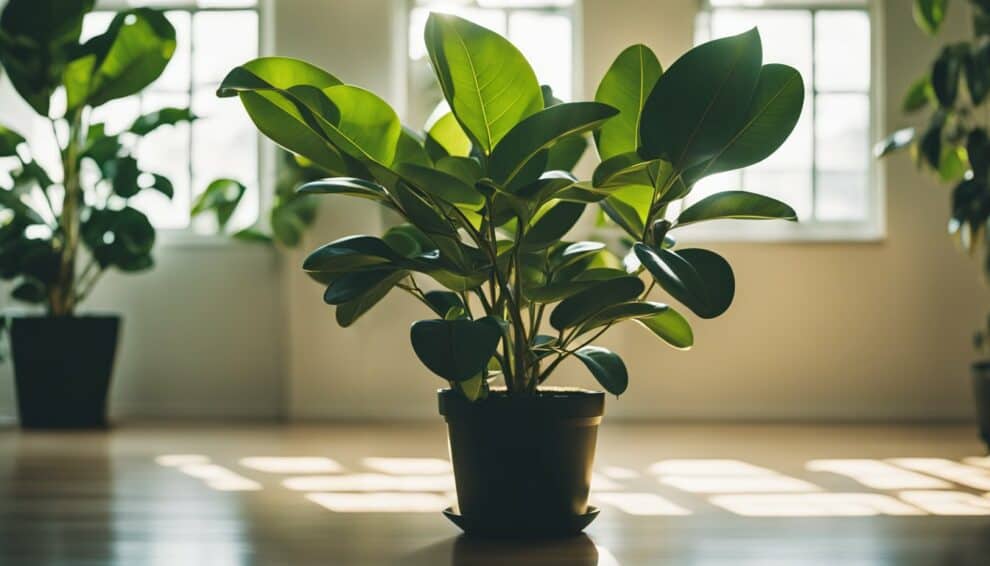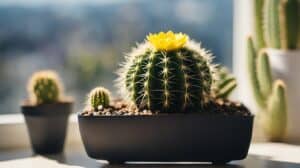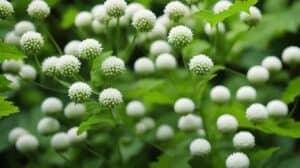Ficus Elastica, commonly known as the rubber plant, is a popular houseplant that has been around for centuries.
Its popularity stems from its unique appearance and ease of care, making it an ideal choice for beginners.
With its large, glossy leaves and stoic beauty, the rubber plant is sure to add a touch of elegance to any home.

One of the most attractive features of the rubber plant is its ability to grow into a large, impressive specimen.
This makes it an excellent choice for those looking to add a statement piece to their home.
With proper care, a rubber plant can grow up to 8 feet tall, creating a stunning focal point in any room.
Additionally, the rubber plant’s large leaves help to purify the air, making it a great choice for those looking to improve their indoor air quality.
Despite its impressive size and beauty, the rubber plant is surprisingly easy to care for.
It thrives in bright, indirect light and prefers to be kept on the drier side, making it a low-maintenance option for even the busiest of homeowners.
With a little bit of love and attention, the rubber plant can provide years of stoic beauty and enjoyment.
Discovering Ficus Elastica
History and Origin
Ficus Elastica, commonly known as the Rubber Plant, is a species of flowering plant in the fig family, native to Southeast Asia.
It has been cultivated for its ornamental value for centuries and has become a popular houseplant in recent years.
The Rubber Plant was first introduced to Europe in the early 1800s and quickly became a popular ornamental plant.
Its name comes from the milky white sap that is produced when the plant is cut, which was used to make rubber in the past.
Species and Varieties
There are several varieties of Ficus Elastica, each with its unique characteristics.
The most common variety is Ficus Elastica Robusta, which has large, glossy leaves that are dark green in color.
Another popular variety is Ficus Elastica Tineke, which has variegated leaves with cream and green stripes.
Ficus Elastica is also available in different sizes, from small tabletop plants to large trees that can grow up to 100 feet tall in their natural habitat.
Overall, Ficus Elastica is an easy-to-care-for plant that can add a touch of greenery and elegance to any home.
Its stoic beauty and low maintenance make it an excellent choice for beginners who are looking to add plants to their home décor.
Caring for Your Rubber Plant

Ideal Soil Mix
Rubber plants thrive in well-draining soil that is rich in nutrients.
A good soil mix for your rubber plant should be a combination of peat moss, perlite, and sand.
This will ensure that the soil is well-draining and provides enough air circulation around the roots.
Watering Essentials
Watering your rubber plant is essential to its growth and overall health. However, overwatering can lead to root rot, which can be fatal to your plant.
It is recommended to water your rubber plant once a week, or when the top inch of soil is dry to the touch.
Make sure to use room temperature water and avoid getting water on the leaves, as this can cause damage.
Light and Temperature Requirements
Rubber plants prefer bright, indirect light. Direct sunlight can scorch the leaves, while too little light can cause the plant to become leggy.
The ideal temperature range for your rubber plant is between 60-75°F (15-24°C).
Avoid placing your plant near drafty windows or doors, as this can cause stress to the plant.
Fertilization and Growth
Rubber plants benefit from regular fertilization during the growing season (spring and summer).
Use a balanced fertilizer every 2-3 weeks to promote healthy growth. As your rubber plant grows, it may need to be repotted into a larger container.
This can be done every 2-3 years, or when the roots start to outgrow the current container.
Common Issues and Solutions

Pest Problems
Rubber plants are prone to pest infestations, especially if they are not given proper care.
Some common pests that can affect your ficus elastica include spider mites, mealybugs, and scale insects.
These pests can cause damage to the plant by sucking the sap from the leaves, which can lead to leaf drop and stunted growth.
To prevent pest infestations, it is important to regularly inspect your rubber plant for any signs of pests.
If you do notice any pests, you can try wiping them off the leaves with a damp cloth or using an insecticidal soap.
For severe infestations, you may need to use a stronger pesticide, but be sure to follow the instructions carefully and avoid using too much.
Leaf Discoloration and Drop
Leaf discoloration and drop can be caused by a variety of factors, including overwatering, underwatering, and exposure to cold temperatures.
If you notice that the leaves of your rubber plant are turning yellow or brown and falling off, it may be a sign that the plant is not getting enough water or is being exposed to cold drafts.
To prevent leaf discoloration and drop, make sure to water your rubber plant regularly and avoid overwatering or underwatering.
You should also make sure to keep your plant away from cold drafts and direct sunlight.
Overwatering Symptoms
Overwatering is a common problem with rubber plants, and it can cause a variety of symptoms, including yellowing leaves, wilting, and root rot.
If you notice that the leaves of your rubber plant are turning yellow and falling off, it may be a sign that you are overwatering your plant.
To prevent overwatering, make sure to allow the top inch of soil to dry out before watering your plant again.
You should also make sure that your plant is in a well-draining pot and that you are not using too much water when you water it.
If you do notice any signs of overwatering, you can try reducing the amount of water you give your plant and allowing the soil to dry out more between waterings.
Propagation Techniques

Cutting Method
The rubber plant can be propagated through stem cuttings. It is best to take cuttings from the top of the plant, where the stem is the newest and healthiest.
The stem should be cut just below a leaf node, and the cutting should be about 6 inches long.
Remove the lower leaves from the cutting, leaving only a few at the top. Dip the cut end in rooting hormone and plant it in a pot filled with moist soil.
Keep the soil moist and the cutting in a warm, bright location. Roots should begin to form in a few weeks, and new growth will appear in a few months.
Layering Method
Another method of propagating rubber plants is through layering.
This involves bending a lower branch of the plant down to the soil and covering it with soil, leaving the tip of the branch exposed.
The branch should be wounded slightly where it touches the soil, to encourage root growth.
After a few weeks, roots should begin to form, and the branch can be cut from the parent plant and potted separately.
This method can take longer than the cutting method, but it allows for a more established plant to be propagated.
Overall, propagation of the rubber plant is relatively easy and can be done with a few simple techniques.
With a little patience and care, you can expand your collection of these stoic beauties.
Frequently Asked Questions

How often should I water my Ficus Elastica?
Rubber plants prefer moist soil, but they do not like to sit in water. It is best to water your Ficus Elastica when the top inch of soil is dry to the touch.
Overwatering can lead to root rot, so be sure to allow the soil to dry out slightly between waterings.
In general, you should water your Rubber Plant about once a week during the growing season and once every two to three weeks during the winter months.
What’s the best lighting condition for a Rubber Plant?
Ficus Elastica prefers bright, indirect light.
Direct sunlight can scorch the leaves, so it is best to place your Rubber Plant near a window that receives filtered light.
If your Rubber Plant is not getting enough light, you may notice that the leaves are turning yellow and falling off.
On the other hand, if your plant is getting too much light, the leaves may appear burnt or brown around the edges.
When and how should I repot my Rubber Plant?
Rubber Plants can become root-bound over time, which means they have outgrown their current pot.
You should repot your Ficus Elastica every two to three years, or when you notice the roots beginning to grow out of the drainage holes.
When repotting, choose a pot that is one size larger than the current pot and use well-draining soil.
Gently loosen the roots before placing the plant in the new pot and water thoroughly.
How can I tell if my Rubber Plant is healthy?
A healthy Rubber Plant will have shiny, dark green leaves that feel firm to the touch.
If the leaves are yellowing or falling off, it may be a sign of overwatering or underwatering.
Brown spots on the leaves can be a sign of too much direct sunlight. Pests such as spider mites or mealybugs can also indicate an unhealthy plant.
What are the common pests to look out for on a Ficus Elastica?
Spider mites and mealybugs are common pests that can infest Rubber Plants. Spider mites are tiny pests that can be difficult to see with the naked eye.
They create fine webs on the leaves and can cause the leaves to turn yellow and fall off.
Mealybugs are small, white insects that feed on the sap of the plant and can cause stunted growth and yellowing leaves.
To prevent and treat pest infestations, regularly inspect your plant and use an insecticidal soap or neem oil.
Can I propagate my Rubber Plant, and if so, how?
Yes, you can propagate your Ficus Elastica by stem cuttings. Take a cutting that is about six inches long and has at least two leaves.
Remove the bottom leaves and dip the cut end in rooting hormone. Plant the cutting in well-draining soil and keep it moist.
Place the pot in a bright, indirect light and wait for roots to form. Once the roots have formed, you can transplant the new plant into a larger pot.














